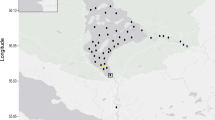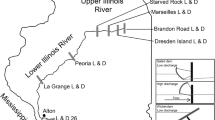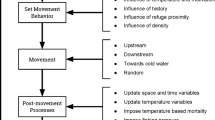Abstract
Successful migration of Chinook Salmon (Oncorhynchus tshawytscha) smolts seaward in the Sacramento – San Joaquin River Delta (hereafter, Delta) requires navigating a network of numerous branching channels. Within the Delta, several key junctions route smolts either towards more direct paths to the ocean or towards the interior Delta, an area associated with decreased survival. Movements within these junctions that determine route choice can be influenced by numerous behavioral and environmental factors, including the complex interplay between tidal and riverine hydraulics. Here, we apply continuous time multistate Markov models to examine the influence of tidal and riverine hydraulics, behavioral factors, and management actions on smolt movements. These models incorporate more information from acoustic telemetry data compared with previous approaches to modeling smolt movements in the Delta. By decomposing modeled flows into tidal and net flow signals we elucidate how each component influences movements into and out of distributary channels. Increasing net flows generally increased movement rates, while flood tides decreased seaward movement rates. Similarly, ebb tides increased downstream movements as fish go with the flow. We found less support for diel movement behaviors compared to flow metrics. Additionally, we quantify the effects of a large management action, the placement of a physical barrier, which was effective at decreasing entrainment into the interior Delta. Together, these results help inform management of Chinook Salmon and increase our understanding of the major factors driving smolt movements within these key junctions.







Similar content being viewed by others
Data availability
The data analyzed during the current study are available from the corresponding author on reasonable request.
References
Adams NS, Plumb JM, Perry RW, Rondorf DW (2014) Performance of a surface bypass structure to enhance juvenile steelhead passage and survival at Lower Granite Dam, Washington. North Am J Fish Manag 34(3):576–594
Brown LR, Bauer ML (2010) Effects of hydrologic infrastructure on flow regimes of California’s Central Valley rivers: implications for fish populations. River Res Appl 26(6):751–765
Buchanan RA, Skalski JR, Brandes PL, Fuller A (2013) Route use and survival of juvenile Chinook salmon through the San Joaquin River Delta. North Am J Fish Manag 33(1):216–229
Buchanan R, Brandes P, Marshall M, Nichols K, Ingram J, LaPlante D, Israel J (2016) 2013 South Delta Chinook Salmon survival study. U.S. Fish and Wildlife Service, Pacific Southwest Region, Lodi Fish and Wildlife Office, Lodi, California
Buchanan RA, Brandes PL, Skalski JR (2018) Survival of juvenile fall-run Chinook Salmon through the San Joaquin River delta, California, 2010–2015. North Am J Fish Manag 38(3):663–679
Buchanan RA, Skalski JR (2020) Relating survival of fall-run Chinook Salmon through the San Joaquin Delta to river flow. Environ Biol Fish 103(5):389–410
Buchanan RA, Buttermore E, Israel J (2021) Outmigration survival of a threatened steelhead population through a tidal estuary. Can J Fish Aquat Sci 78(12):1869–1886
Burnham KP, Anderson DR (1998) Practical use of the information-theoretic approach. In Model selection and inference. Springer, New York, NY, pp. 75–117
California Department of Water Resources (2009) DSM2 v8.1.2 Calibration. California Natural Resources Agency. https://data.cnra.ca.gov/dataset/dsm2-v8-1-2-calibration. Accessed 21 Sept 2021
Cavallo B, Gaskill P, Melgo J, Zeug SC (2015) Predicting juvenile Chinook Salmon routing in riverine and tidal channels of a freshwater estuary. Environ Biol Fish 98(6):1571–1582
Chapman ED, Hearn AR, Michel CJ, Ammann AJ, Lindley ST, Thomas MJ, Sandstrom PT, Singer GP, Peterson ML, MacFarlane RB, Klimley AP (2013) Diel movements of out-migrating Chinook salmon (Oncorhynchus tshawytscha) and steelhead trout (Oncorhynchus mykiss) smolts in the Sacramento/San Joaquin watershed. Environ Biol Fish 96(2):273–286
Evans SD, Adams NS, Rondorf DW, Plumb JM, Ebberts BD (2008) Performance of a prototype surface collector for juvenile salmonids at Bonneville Dam’s first powerhouse on the Columbia River, Oregon. River Res Appl 24(7):960–974
Godin G (1972) The analysis of tides. University of Toronto Press, Toronto
Hance DJ, Perry RW, Burau JR, Blake A, Stumpner P, Wang X, Pope A (2020) Combining models of the critical streakline and the cross-sectional distribution of juvenile salmon to predict fish routing at river junctions. San Francisco Estuary and Watershed Science 18(1)
Hayhoe K, Cayan D, Field CB, Frumhoff PC, Maurer EP, Miller NL, Moser SC, Schneider SH, Cahill KN, Cleland EE, Dale L (2004) Emissions pathways, climate change, and impacts on California. Proc Natl Acad Sci 101(34):12422–12427
Jackson C (2011) Multi-state models for panel data: the msm package for R. J Stat Softw 38(1):1–28
Johnson GE, Dauble DD (2006) Surface flow outlets to protect juvenile salmonids passing through hydropower dams. Rev Fish Sci 14(3):213–244
Lennox RJ, Paukert CP, Aarestrup K, Auger-Méthé M, Baumgartner L, Birnie-Gauvin K, Bøe K, Brink K, Brownscombe JW, Chen Y, Davidsen JG (2019) One hundred pressing questions on the future of global fish migration science, conservation, and policy. Front Ecol Evol 7:286
Lindsey JK (2004) Statistical analysis of stochastic processes in time, vol 14. Cambridge University Press, Cambridge
Maurer EP (2007) Uncertainty in hydrologic impacts of climate change in the Sierra Nevada, California, under two emissions scenarios. Clim Change 82(3):309–325
Metcalfe NB, Fraser NH, Burns MD(1998) State–dependent shifts between nocturnal and diurnal activity in salmon. Proc R Soc Lond B Biol Sci 265(1405):1503–1507
Metcalfe NB, Fraser NH, Burns MD (1999) Food availability and the nocturnal vs. diurnal foraging trade-off in juvenile salmon. J Anim Ecol 68(2):371–381
National Research Council (1996) Upstream: salmon and society in the Pacific Northwest. National Academies Press ,Washington
Newman KB, Brandes PL (2010) Hierarchical modeling of juvenile Chinook salmon survival as a function of Sacramento–San Joaquin Delta water exports. North Am J Fish Manag 30(1):157–169
Nichols FH, Cloern JE, Luoma SN, Peterson DH (1986) The modification of an estuary. Science 231(4738):567–573
Perry RW, Brandes PL, Burau JR, Klimley AP, MacFarlane B, Michel C, Skalski JR (2013) Sensitivity of survival to migration routes used by juvenile Chinook salmon to negotiate the Sacramento-San Joaquin River Delta. Environ Biol Fish 96(2):381–392
Perry R, Romine JG, Adams NS, Blake AR, Burau JR, Johnston SV, Liedtke TL (2014) Using a non-physical behavioral barrier to alter migration routing of juvenile chinook salmon in the Sacramento–San Joaquin River delta. River Res Appl 30(2):192–203
Perry RW, Brandes PL, Burau JR, Sandstrom PT, Skalski JR (2015) Effect of tides, river flow, and gate operations on entrainment of juvenile salmon into the interior Sacramento–San Joaquin River Delta. Trans Am Fish Soc 144(3):445–455
Perry RW et al (2018) Flow-mediated effects on travel time, routing, and survival of juvenile Chinook salmon in a spatially complex, tidally forced river delta. Can J Fish Aquat Sci 75(11):1886–1901
Plumb JM, Adams NS, Perry RW, Holbrook CM, Romine JG, Blake AR, Burau JR (2016) Diel activity patterns of juvenile late fall-run Chinook Salmon with implications for operation of a gated water diversion in the Sacramento–San Joaquin River Delta. River Res Appl 32(4):711–720
R Core Team (2021) R: A language and environment for statistical computing. R Foundation for Statistical Computing, Vienna. http://www.R-project.org/
Romine JG, Perry RW, Pope AC, Stumpner P, Liedtke TL, Kumagai KK, Reeves RL (2016) Evaluation of a floating fish guidance structure at a hydrodynamically complex river junction in the Sacramento–San Joaquin River Delta, California, USA. Mar Freshw Res 68(5):878–888
Romine JG, Perry RW, Stumpner PR, Blake AR, Burau JR (2021) Effects of tidally varying river flow on entrainment of juvenile salmon into sutter and steamboat sloughs. San Francisco Estuary and Watershed Science 19(2)
Steel AE, Sandstrom PT, Brandes PL, Klimley AP (2013) Migration route selection of juvenile Chinook salmon at the Delta Cross Channel, and the role of water velocity and individual movement patterns. Environ Biol Fish 96(2):215–224
Thieurmel B, Elmarhraoui A(2019) suncalc: Compute Sun Position, Sunlight Phases, Moon Position and Lunar Phase. R package version 0.5.0. https://CRAN.R-project.org/package=suncalc. Accessed Oct 2021
Acknowledgements
This work was funded by California Department of Water Resources. We extend special thanks to Ryan Reeves and William McLaughlin for their support. We thank Summer Burdick, Rebecca Buchanan, Bryan Matthias and anonymous reviewers. Further, we thank the many people and agencies who oversaw and implemented fish tagging, care, and release, and acoustic receiver installation, maintenance, retrieval, and processing. The data analyzed during the current study are available from the corresponding author on reasonable request. Any use of trade, firm, or product names is for descriptive purposes only and does not imply endorsement by the U.S. Government.
Funding
This work was funded by California Department of Water Resources.
Author information
Authors and Affiliations
Corresponding author
Ethics declarations
Ethical approval
All animal care and handling was approved and followed strict guidelines put forth by the U.S. Fish and Wildlife Service.
Conflict of interest
There is no conflict of interest declared in the article.
Financial interests
The authors have no relevant financial or non-financial interests to disclose.
Additional information
Publisher’s note
Springer Nature remains neutral with regard to jurisdictional claims in published maps and institutional affiliations.
Supplementary Information
Below is the link to the electronic supplementary material.
ESM 1
(DOCX 4.88 MB)
Rights and permissions
About this article
Cite this article
Dodrill, M.J., Perry, R.W., Pope, A.C. et al. Quantifying the effects of tides, river flow, and barriers on movements of Chinook Salmon smolts at junctions in the Sacramento – San Joaquin River Delta using multistate models. Environ Biol Fish 105, 2065–2082 (2022). https://doi.org/10.1007/s10641-022-01273-1
Received:
Accepted:
Published:
Issue Date:
DOI: https://doi.org/10.1007/s10641-022-01273-1




